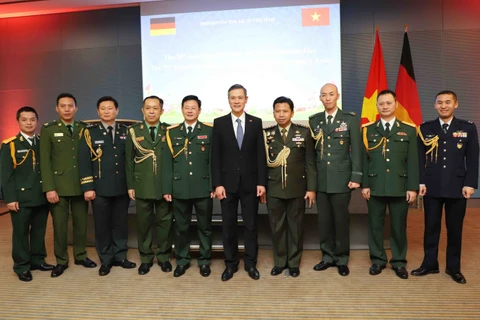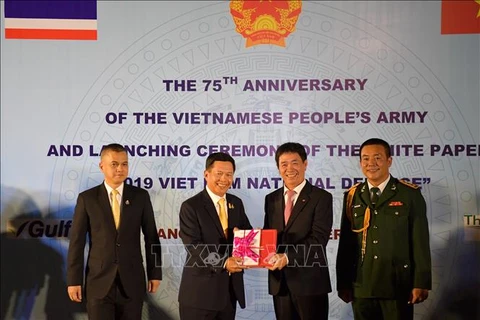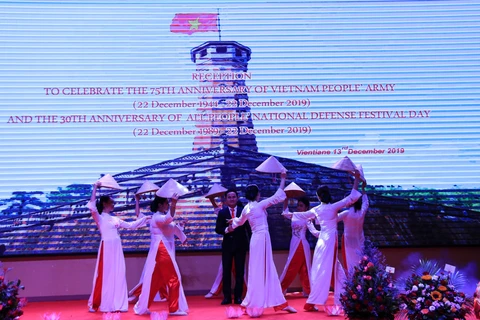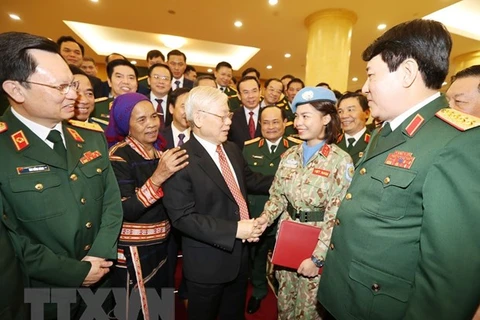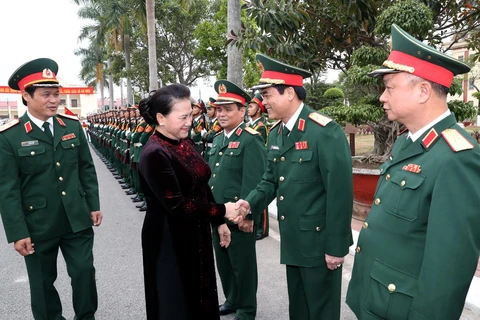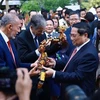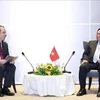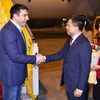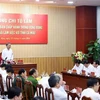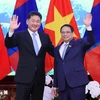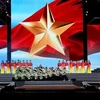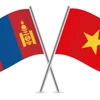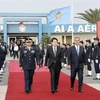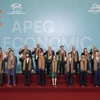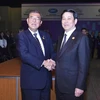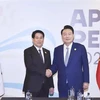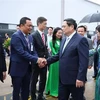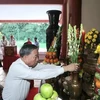 The Command of the Dien Bien Phu Campaign against French colonialists in 1954: President Ho Chi Minh (centre), General – Commander-in-chief Vo Nguyen Giap (first, right) and other officials (File photo: VNA)
The Command of the Dien Bien Phu Campaign against French colonialists in 1954: President Ho Chi Minh (centre), General – Commander-in-chief Vo Nguyen Giap (first, right) and other officials (File photo: VNA) Hanoi (VNA) – During the country’s thousands-of-years history, the Vietnamese people unyieldingly fought to regain and safeguard their independence. Those struggles have bequeathed an extremely valuable heritage, the unique military art that is deeply imbued with humanity.
No compromise with invaders
In the fights to regain and defend national independence and resist foreign domination, the Vietnamese people always kept united and undaunted in the face of brutal invaders.
In the great cause of national defence, there were preeminent generals who went down in history such as Ngo Quyen, Ly Thuong Kiet, Tran Hung Dao, Nguyen Trai and Quang Trung – Nguyen Hue. They were national heroes who were not only skilful in the art of war but also humane thinkers respected even by enemies.
In each historical period, Vietnam had appropriate ways to safeguard the country and people’s lives.
History has proved that the country’s military art is permeated with the idea of active attack on enemies, or in other words, the strategic idea of offensive, which shows the boldness and determination to attack and defeat invaders. That enhanced the whole people’s solidarity, confidence in victory, and unyieldingness in the face of invaders regardless of the enemies’ strength and ferocity.
The economic and military strength of all invaders in history dwarfed Vietnam’s, and they thoroughly capitalised on their troop, weapon and equipment advantages to launch swift attacks to gain swift victories in the hope of crushing the combat willingness of and forcing the Vietnamese people to yield.
Facing such situations, the country’s feudal dynasties carried out many policies to safeguard the nation, which included arousing people’s bravery and steadfastness in combat.
In the 20th century, the patriotism and military culture of Vietnam could be seen in President Ho Chi Minh’s appeals: “Nothing is more precious than independence and freedom” or “we must gain independence even if we have to burn down the entire Truong Son Range”, which prompted all the 54 ethnic groups to stand up to the enemy and defend the nation.
All people join in combating enemies
 A US pilot is under arrest beside the wreck of a jet fighter in the “Hanoi – Dien Bien Phu on air” victory in 1972 (Photo: VNA)
A US pilot is under arrest beside the wreck of a jet fighter in the “Hanoi – Dien Bien Phu on air” victory in 1972 (Photo: VNA) Continually having to face powerful and brutal invaders, the country’s military policy in every period is to call on the whole people to join in the fights.
To firmly safeguard the country, feudal dynasties had the consistent viewpoint of uniting the community and bringing into play the strength of the whole nation to defeat invaders.
In the era of Ho Chi Minh, this idea was not only applied creatively but also developed to a new height as reflected through the leader’s saying: “Unity, unity, great unity/ Success, success, great success.”
The Party’s constant guideline in the struggle for national liberation was to carry out people’s war that mainly relied on internal strength. Besides, the Party also maximised the national strength along with the strength of the era to fight against enemies in all the three battlefields: military, politics and diplomacy.
 On October 10, 1954, units of Brigade 308 were divided into many groups to launch a historic march to take over Hanoi from French colonialists in the warm welcome of 200,000 local residents (File photo: VNA)
On October 10, 1954, units of Brigade 308 were divided into many groups to launch a historic march to take over Hanoi from French colonialists in the warm welcome of 200,000 local residents (File photo: VNA) Thanks to the sound military policies, the Party mobilised all people for the resistance wars, thereby creating combined strength to obtain partial victories and then complete victories.
Humanity in Vietnam’s military art
The military art of Vietnam is special as it applies a wide range of creative combat methods to gain triumphs while causing minimum losses to both sides.
 The signing ceremony of the Paris Peace Accords at the International Conference Centre in the French capital on January 27, 1973 (Photo: VNA)
The signing ceremony of the Paris Peace Accords at the International Conference Centre in the French capital on January 27, 1973 (Photo: VNA) As the winner of the struggles, instead of annihilating invaders, Vietnam always sought to give the enemies chances to return home safely, which was also a prerequisite for both sides to build friendship later.
Kings of the Tran Dynasty ensured safety for the Yuan troops to retreat, King Le Loi provided supplies for the defeated Ming army to return to their country. In the 20th century, Vietnam also created conditions for French and US troops to withdraw.
Through such acts, the Vietnamese people showed the burning aspiration for peace and friendship with all nations around the world.
In the battlefield of diplomacy, the Party and State’s principled and friendly viewpoint at the peace talks in Fontainebleau, Geneva and Paris demonstrated Vietnam as a peace-loving and humane nation.
This precious heritage illustrated former generations’ outstanding skillfulness in the art of war, and it has been inherited, brought into play and developed to a new height by following generations./.

